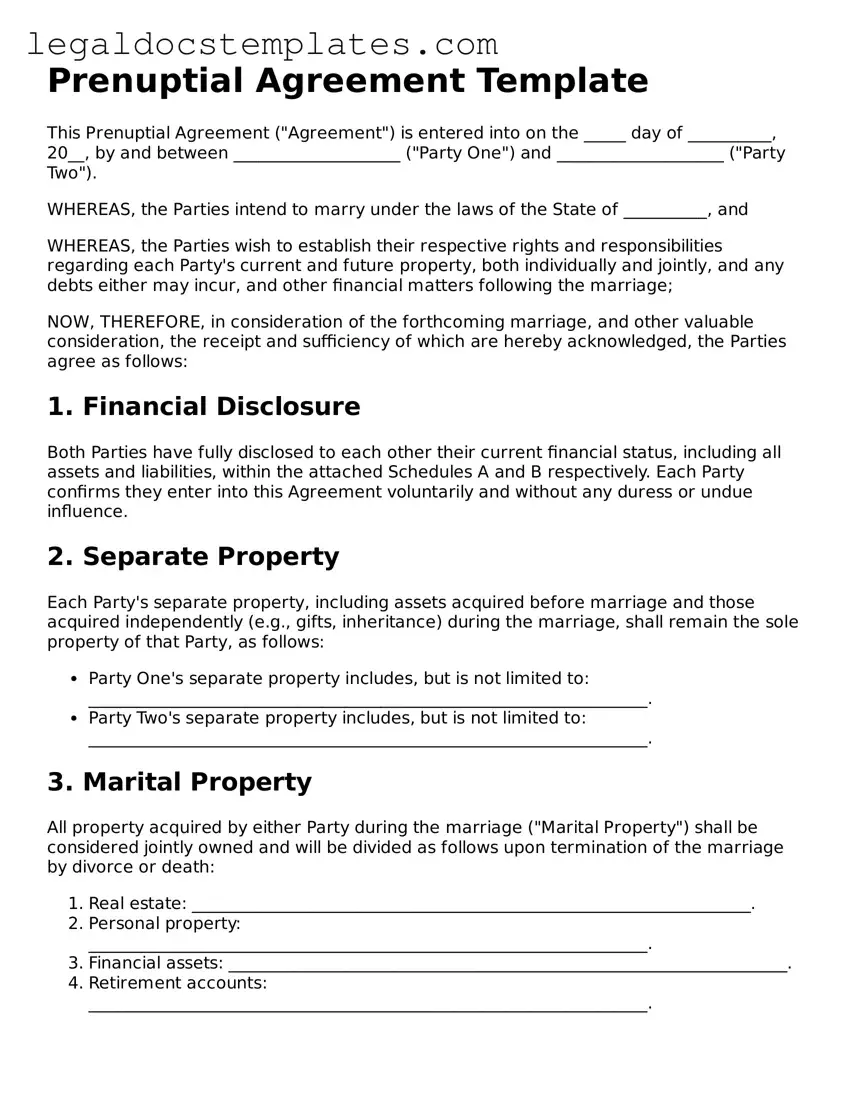Prenuptial Agreement Template
This Prenuptial Agreement ("Agreement") is entered into on the _____ day of __________, 20__, by and between ____________________ ("Party One") and ____________________ ("Party Two").
WHEREAS, the Parties intend to marry under the laws of the State of __________, and
WHEREAS, the Parties wish to establish their respective rights and responsibilities regarding each Party's current and future property, both individually and jointly, and any debts either may incur, and other financial matters following the marriage;
NOW, THEREFORE, in consideration of the forthcoming marriage, and other valuable consideration, the receipt and sufficiency of which are hereby acknowledged, the Parties agree as follows:
1. Financial Disclosure
Both Parties have fully disclosed to each other their current financial status, including all assets and liabilities, within the attached Schedules A and B respectively. Each Party confirms they enter into this Agreement voluntarily and without any duress or undue influence.
2. Separate Property
Each Party's separate property, including assets acquired before marriage and those acquired independently (e.g., gifts, inheritance) during the marriage, shall remain the sole property of that Party, as follows:
- Party One's separate property includes, but is not limited to: ___________________________________________________________________.
- Party Two's separate property includes, but is not limited to: ___________________________________________________________________.
3. Marital Property
All property acquired by either Party during the marriage ("Marital Property") shall be considered jointly owned and will be divided as follows upon termination of the marriage by divorce or death:
- Real estate: ___________________________________________________________________.
- Personal property: ___________________________________________________________________.
- Financial assets: ___________________________________________________________________.
- Retirement accounts: ___________________________________________________________________.
4. Debts
Any debts incurred by either Party during the marriage shall be paid from Marital Property, unless agreed otherwise. Separate debts shall remain the responsibility of the Party incurring the debt.
5. Amendments and Termination
This Agreement can only be amended or terminated by a written document signed by both Parties. No oral agreements, prior or subsequent, shall be deemed to amend this Agreement.
6. Governing Law
This Agreement shall be governed by the laws of the State of __________, without regard to its conflict of law principles.
7. Entire Agreement
This document, along with its attachments, constitutes the entire agreement between the Parties regarding the subject matter hereof and supersedes all prior agreements or understandings, whether written or oral.
Signatures
IN WITNESS WHEREOF, the Parties have executed this Agreement on the dates written below, each acknowledging that they understand and agree to its terms.
Party One: ___________________________________ Date: ________________
Party Two: ___________________________________ Date: ________________
